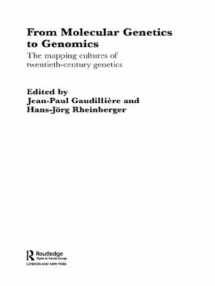
From Molecular Genetics to Genomics: The Mapping Cultures of Twentieth-Century Genetics (Routledge Studies in the History of Science, Technology and Medicine)
ISBN-13:
9780415328500
ISBN-10:
0415328500
Edition:
1
Author:
Hans-Jörg Rheinberger, Jean-Paul Gaudilliere
Publication date:
2004
Publisher:
Routledge
Format:
Hardcover
244 pages
FREE US shipping
Book details
ISBN-13:
9780415328500
ISBN-10:
0415328500
Edition:
1
Author:
Hans-Jörg Rheinberger, Jean-Paul Gaudilliere
Publication date:
2004
Publisher:
Routledge
Format:
Hardcover
244 pages
Summary
From Molecular Genetics to Genomics: The Mapping Cultures of Twentieth-Century Genetics (Routledge Studies in the History of Science, Technology and Medicine) (ISBN-13: 9780415328500 and ISBN-10: 0415328500), written by authors
Hans-Jörg Rheinberger, Jean-Paul Gaudilliere, was published by Routledge in 2004.
With an overall rating of 4.4 stars, it's a notable title among other
books. You can easily purchase or rent From Molecular Genetics to Genomics: The Mapping Cultures of Twentieth-Century Genetics (Routledge Studies in the History of Science, Technology and Medicine) (Hardcover) from BooksRun,
along with many other new and used
books
and textbooks.
And, if you're looking to sell your copy, our current buyback offer is $0.3.
Description
With the rise of genomics, the life sciences have entered a new era. Maps of genomes have become the icons for a comprehensive knowledge of the organism on a previously unattained level of complexity, and the organisation of genetic knowledge in maps has been a major driving force in the establishment of the discipline. This book provides a comprehensive history of molecular genetics and genomics.The first section of the book shows how the genetic cartography of classical genetics was linked to the molecular analysis of gene structure through the introduction of new model organisms such as bacteria and through the invention of new experimental tools such as gene transfer. The second section addresses the moral and political economy of human genome sequencing in all its technical, epistemic, social and economic complexity.With detailed analyses of the scientific practices of mapping and its illustration of the diversity of mapping practices this book is a significant contribution to the history of genetics. A companion volume from the same editors - Classical Genetic Research and Its Legacy: The Mapping Cultures of Twentieth Century Genetics - covers the history of mapping procedures as they were developed in classical genetics.


We would LOVE it if you could help us and other readers by reviewing the book
Book review

Congratulations! We have received your book review.
{user}
{createdAt}
by {truncated_author}


